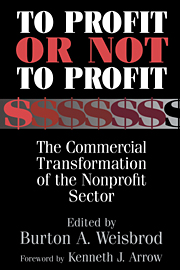Book contents
- Frontmatter
- Contents
- List of contributors
- Foreword by Kenneth J. Arrow
- Preface
- 1 The nonprofit mission and its financing: Growing links between nonprofits and the rest of the economy
- Part I Basic issues and perspective
- Part II Industry studies
- Part III Overview, conclusions, and public-policy issues
- 14 Commercialism among nonprofits: Objectives, opportunities, and constraints
- 15 Conclusions and public-policy issues: Commercialism and the road ahead
- Appendix: IRS Forms 990 and 990-T for nonprofit organizations
- References
- Index
14 - Commercialism among nonprofits: Objectives, opportunities, and constraints
Published online by Cambridge University Press: 30 November 2009
- Frontmatter
- Contents
- List of contributors
- Foreword by Kenneth J. Arrow
- Preface
- 1 The nonprofit mission and its financing: Growing links between nonprofits and the rest of the economy
- Part I Basic issues and perspective
- Part II Industry studies
- Part III Overview, conclusions, and public-policy issues
- 14 Commercialism among nonprofits: Objectives, opportunities, and constraints
- 15 Conclusions and public-policy issues: Commercialism and the road ahead
- Appendix: IRS Forms 990 and 990-T for nonprofit organizations
- References
- Index
Summary
Introduction
Earlier chapters in this book provide a comprehensive picture of growing commercialism among nonprofit organizations. Commercialism is defined to mean the degree of reliance on sales revenues rather than donations or government grants, the production of goods for sale that compete with goods produced by for-profit organizations, collaborations and partnerships with for-profits, and, ultimately, conversion into for-profits. The book attempts to answer the questions: Is commercialism increasing? If so, why and so what? Should it be encouraged or discouraged by public policy? Is growing commercialism good because it allows nonprofits to flourish and grow, or bad because it makes them more like for-profits? Here I contrast the arguments set forth in this book with a contrary hypothesis about nonprofit behavior and why it appears to be changing. I review the evidence provided to see which view of the nonprofit world is most consistent with the facts, and discuss some of the public-policy implications.
The book depicts nonprofit organizations as having different and more altruistic objective functions than for-profits, which lead them to engage in commercial activities marginally and reluctantly, in order to cross-subsidize their preferred noncommercial activities, when other revenue sources such as donations and subsidies are not available. In fact, this is a point of view that I have espoused in the past, and I believe it is consistent with long-standing behavior in some organizations, such as universities.
However, the contrary hypothesis that I shall examine here is stimulated by empirical observations in this book, indicating that the most dramatic growth in commercialism has occurred in situations where institutional or legal constraints on sales revenues were lifted, revealing large new opportunities.
- Type
- Chapter
- Information
- To Profit or Not to ProfitThe Commercial Transformation of the Nonprofit Sector, pp. 271 - 286Publisher: Cambridge University PressPrint publication year: 1998
- 37
- Cited by

